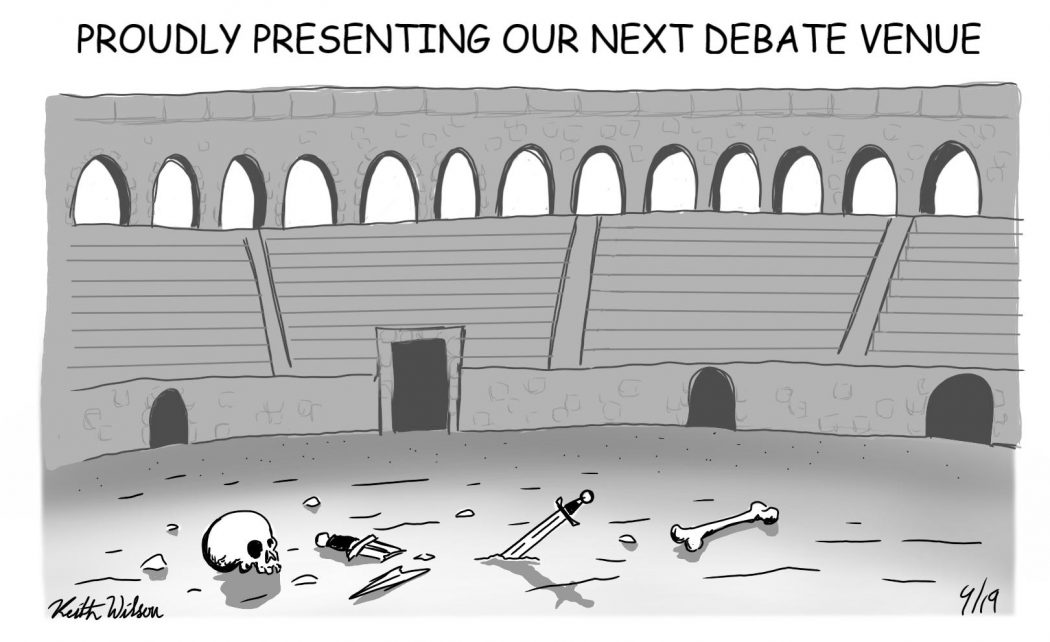Can the Democratic Picture Ever Fit the Frame?
On Thursday, September 12, the Democratic Party’s presidential hopefuls took the debate stage for the third time in 2019 to confront their political opponents and the inevitable attacks on their policy ideals. While the field has continued to narrow in the past three months, the country still found themselves face-to-face with ten potential nominees. If the oversaturation of the field isn’t enough, the responses of pundits and political journalists following the debate is an overwhelming illustration of the Democratic Party’s endemic fragmentation.
While progressives, like Bernie Sanders and Elizabeth Warren, managed to navigate questions without pointing fingers at their opponents, the same cannot be said about former Vice President Joe Biden. As Ayesha Rascoe notes in NPR’s Politics Podcast, Biden’s speaking time was the longest of the evening at 17 minutes and 8 seconds, and most of his time in the limelight was spent either taking aim at any healthcare plan that wasn’t riding the coattails of Obamacare, or fumbling questions addressing race and socioeconomic inequality.
Much to Twitter’s relief, Biden’s answer to ABC’s Linsey Davis’ question on repairing the legacy of slavery provided plenty of opportunity for reprimand. Friday morning, Jamil Smith’s Rolling Stone article titled “Why It’s Time for Joe to Go” walked the red carpet of retweets after it outlined Biden’s inability to combat the inherent racism of the current Trumpian paradigm. Smith concluded by asserting that Democratic nominee should be someone more equipped than Biden to share a stage with a certain incisive and antagonistic Republican incumbent.
While most retweets echoed Smith’s accusatory tone, a more humanistic approach came from Crooked Media’s Jon Favreau, who tweeted out a Vox article outlining the Vice President’s plans to uplift historically low-income areas ravaged by institutionalized racism through social work and neo-natal home visits.
I’d be doing a disservice if I didn’t acknowledge that these ten candidates are first and foremost human beings. Holding them to the unrealistically high standards of public scrutiny is a recipe for Trump 2020. But coddling them – and excusing dismissive tones and incomprehensible answers to serious questions – is a poor use of empathy. Isn’t unintelligible rambling something out of Trump’s toolbox the left identifies as disqualifying?
Biden’s plan addressed the serious disparity of access to educational resources between privileged and disadvantaged households, but he’s ultimately responsible for communicating that plan to the public. If he inadvertently conveys an internalized racial bias, shouldn’t we urge pundits to hold him accountable? “Meaning well” is never an excuse for doing harm, and the lack of accountability in Democratic discourse may largely be responsible for propping up polarizing candidates during a time when the party itself has no foundational policy.
In regards to the debate, representative Ocasio-Cortez tweeted out Friday that “‘Civility’ is too often used as a dog whistle for tone policing, while concerning moments…get a pass.”
I’m inclined to agree with her.
Democratic hopefuls seem to cling to the notion that being civil and polite on the debate stage will distinguish them from their Republican counterparts, or make up for lack of feasibility in policy approach. However, this often leaves the right to frame all political discourse. So much so that most of ABC’s commentary between debate segments was centered around which candidate seemed best equipped to face off against the right in 2020.
I would prefer to avoid making my address of the third Democratic debate about Trump or the Republican party, but these circumstances are unfortunate proof that the fragmentation in the left has led them to take the defensive when addressing the American people.
While no politician is truly autonomous, this reality will chip away at our ten Democratic candidates in the following months, testing their ability to put forth substantive addresses for voters on both sides of the political spectrum. All this while they attempt to fight a framing that lies largely out of their hands.
The third debate was an opportunity for these candidates to campaign in front of a different audience than social media provides, but it also showed little deviation from the debates before. Only time will tell if the Democratic Party will challenge the path set for them, if they can bridge the great divide between the far-left voter and their moderate neighbor.

